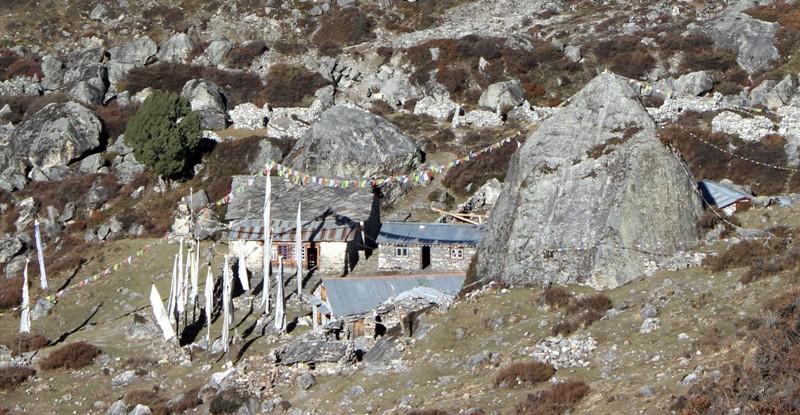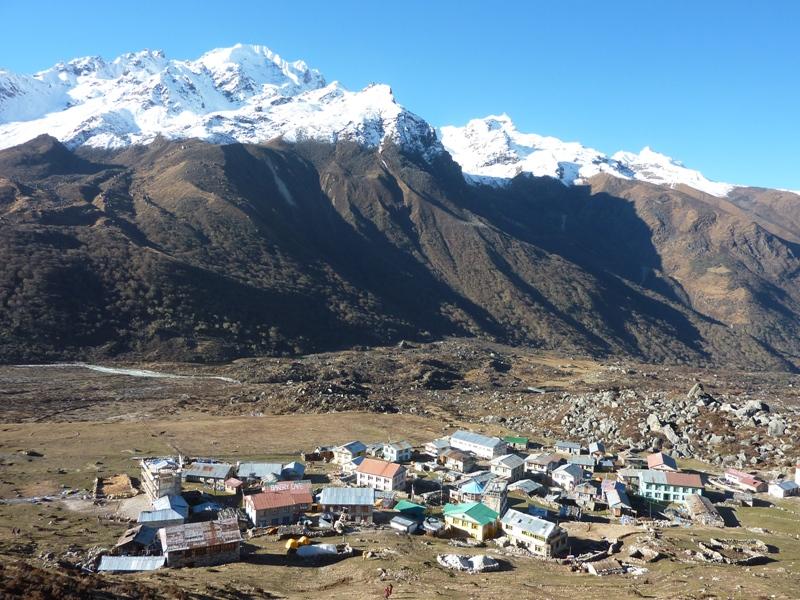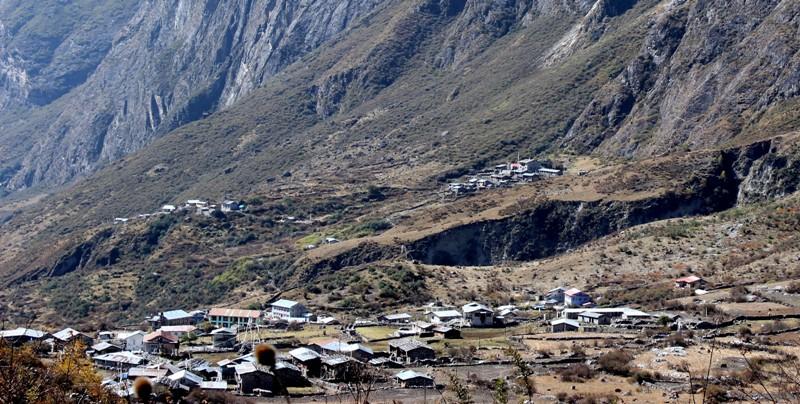On the return leg of the Gonsaikunda trek, centered on the famous Gosaikunda Lake in the Langtang National Park in Nepal, I was attracted by a range of mountains to the northwest of Kathmandu. Asking a tourist guide about it, he replied that the Langtang Valley lay beyond, and I instantly made up my mind: my next trek would be to this mountain valley famous for its colorful spring flowers, shy red pandas, and the Buddhist shrine Kyanjin Gompa, which lies at a staggering altitude of 12,631 feet in the lap of Langtang Lirung peak (23,773 feet).
When at last I set out with three colleagues from Kathmandu towards the village of Syafrubesi in Rasuwa District, it was October 2013, and winter had just begun. After an exhausting eight-hour journey we reached Syafrubesi, where we stopped for the night. Prayer flags welcomed and blessed us as we trekked for two days through the dense oak, rhododendron, and pine forests along the Langtang River towards the village of Langtang, which is inhabited mostly by the Tamang people. The next morning, we left the village and walked for another four hours through scenic rocky terrain, often encountering yaks along the trail. Finally, we were overjoyed to find ourselves in a settlement enclosed by snow-capped mountains—we had reached Kyanjin Gompa at last!
The gompa is in the foothills of Langtang Lirung, Dorje Lakpa, and Langshisha Ri. “The exact age cannot be ascertained, but it must be around six centuries old,” claims Thiley Lama, the head of the Dhomare clan responsible for the stewardship of Kyanjin Gompa until a decade ago. “Even the thangkas adorning the walls were brought from Tibet about four hundred years ago.”
The local construction materials are stone and wood, and the white color gives the gompa a natural appearance, in keeping with its surroundings. Inside are Buddha images made of clay and metal and 13 clay statues of the ancestors of the Dhomares (“Dhomare” means “the inhabitants of the land of red rocks”). The metal statue of Guru Rinpoche is a recent addition, installed just three years ago. A large stone sits in the center of the monastery—the locals believe it to be a frog and that it has been there since the gompa was built. The prayer flags, butter lamps, and fragrance of incense add to the serene ambience.
The story of Langtang and Kyanjin Gompa is closely connected with Tibet. The following legends as recounted by Thiley Lama are perhaps the first of the stories regarding Langtang.
Centuries ago in Tibet, there was an ox that learned that both it and a nak (female yak) were going to be killed for the feast in a marriage ceremony. They ran away to the Langtang area, where the nak disappeared. To bring them back, Guru Rinpoche followed them and found the ox resting in the spot where Langtang village lies today. The name “Langtang” derives from “lang” meaning “ox” and “dhong” meaning “satiated,” and it is said that Guru Rinpoche built a chorten here. Unfortunately, on the way back to Tibet, the ox died at Langshisha Ri.
Many centuries later in Tibet, the ancestor of the Dhomares in the Langtang region, Mingyur Dorje Dhomare, had a dream of a devastating war. Seeking to find a safe place for himself and his family, he threw his phurba (ritual dagger) into the air. It landed over the mountains in Langtang, which was then a small village with only a few households. Believing this to indicate that he should settle there, he came from Tibet with a friend, a tea kettle, and a mask of their deity. Now, in a place called Mundu in Langtang Valley there lived a lama named Jho Rang Rik who, testing the powers of Mingyur Dorje Dhomare, discovered that the latter was much more powerful than he was. Jho Rang Rik decided to flee, whereupon the local people asked Mingyur Dorje Dhomare to build a monastery. Although he didn’t do so, his elder son later built Langtang Monastery in the village and the younger one built Kyanjin Monastery, further away at the foot of the mountains. Thus, the people of Langtang Valley got their temples and altars, and were able to pay homage to their deities.
Tsering Jangmu Lama, the proprietor of Yeti Guest House at Kyanjin, said that tourist arrivals began in Kyanjin after 1955, adding that during the peak season, both domestic and international tourists mostly flocked there to see the mountains, glaciers, and the flora and fauna. However, she was concerned about the deteriorating condition of the monastery, which attracts devotees from Nuwakot, Helambu, and Rasuwagadhi in Nepal and even from Tibet for the fasting practice of “Nyungne” during Saka Dawa (the fourth and the holiest month in the Tibetan Buddhist calendar) and the celebration of “Dukpa Chhiju” in August, when sacred dances are performed in the gompa.
Thiley Lama is not happy with the way Kyanjin Gompa is being promoted by the Nepalese government and by tourism entrepreneurs. “Kyanjin should not be publicized just as a mesmerizing mountain valley; we should be able to propagate the spiritual richness of this region too,” he says. “The precious heritage has suffered thefts and neglect. Many of the old thangkas and sacred books have already been stolen.” He is worried that the true story of the valley will remain only in the Tanding Yang Sang, the collection of the rituals of the Dhomares, remaining an untold enigma to the outside world.
Kyanjin Valley has become a major tourist site, attracting thousands of people every year. Although it evolved as a religious and spiritual sanctuary, the irony is that despite the vicinity being named after the gompa, that aspect remains almost hidden. It seems that the majestic mountains have overshadowed the tale that the fluttering prayer flags at their foothills long to unfold.This article is based on the author’s visit to Kyanjin Gompa in October 2013. The legends related by Thiley Lama Dhomare were translated from the Tanding Yang Sang, the book of rituals of the Dhomares.
















